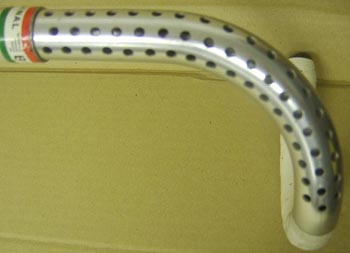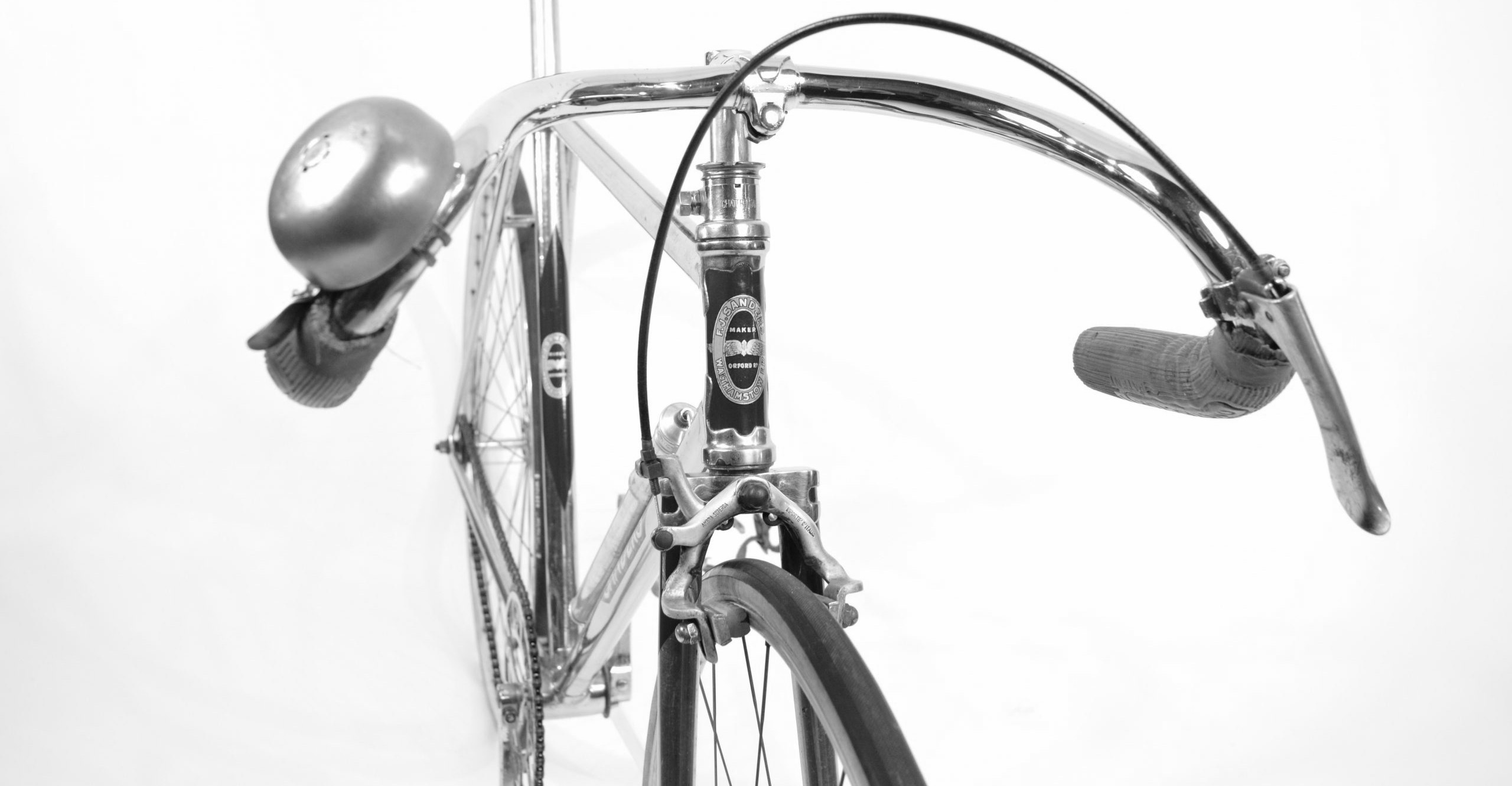Technologies for speed in 20th century competitive cycling
Posted: Monday 17th August 2020
From the very beginnings of competitive cycling on road and track in the 19th century, increasing one’s speed without requiring a commensurate increase in physical effort (‘power output’) has remained the racing cyclist’s ‘Holy Grail’. This is as true of the track sprinter as it is for the long distance time trialist or road rider. Fads and fashions for achieving this have come and gone down the years.
However, in the second half of the 20th century, two successive strategies for doing so became increasingly popular in racing circles. The first was a quest for the ‘superlight’ racing machine; the second, which still predominates today, was an increasing obsession with the holistic aerodynamics –‘ergonomics’ – of the combined rider/machine. Both strategies had been pursued erratically earlier in the century with limited success and varying degrees of acceptance but it was only in its last few decades that they achieved widespread popularity.

The obsessive quest for super lightness began in earnest in the 1960s. It took two main forms: firstly, the construction of frames from extralight steel tubing, most notably Reynolds 531SL and 753 and Columbus SL and PL; secondly, reducing the weight of components by post–production customised ‘drilling out’ of brake callipers and levers, chain sets and also gear levers as well as seat posts.
In the wake of this trend, component manufacturers themselves introduced weight–saving slots in products (Campagnolo’s Super Record front changer cages being an early example) while Zeus famously peppered their chain rings with innumerable small holes. Some British bespoke frame builders even painstakingly cut out slots in the tubing of the front forks and rear triangles as well as bottom bracket shells to further lighten time trial frames. The quest for super lightness reached its apotheosis in the machine which the Italian master frame designer and builder, Ernesto Colnago, crafted for Eddy Merckx to set his definitive hour record of 49.431 Km. in Mexico City in 1972. As Fotheringham (2010: 200) notes: ‘Merckx…used what was then cutting–edge technology, reflecting the idea that what mattered was making the bike as light as possible. His handlebars had 48 drill holes. 95 gm were saved by drilling every slot in the chain…specially light tubular tyres (70 gm) and used titanium for spokes, stem and bars.’
Merckx’s complete record–breaking machine, with a frame constructed by Colnago (in association with Mexico’s ‘Windsor’ cycles) in steel Columbus PL tubing (reputedly with some tubes sourced from Reynolds), weighed in at 12½ pounds. Subsequently, the pursuit of further weight reductions saw frame builders like ALAN in Italy, Vitus in France and Cannondale in the USA using aluminium tubes followed by carbon fibre tubing while others such as Litespeed in the US experimented with titanium tubes and some like Kirk even flirted with frames cast from magnesium alloy.
However, the quest for the super lightweight machine was suddenly overshadowed by the ‘aerodynamic revolution’ of the 1980s. Precipitated first by Francesco Moser’s decisive beating of Merckx’s hour record on a radically aerodynamic machine to reach 51.151 Km in 1984 and then by Greg Lemond’s stunning last–gasp Tour de France victory in 1987 using a low profile machine with tribars and aero kit in the last stage time trial, the obsession with aerodynamics has continued ever since. In its more advanced forms it has involved the use of scientific testing of both riders and machines in wind tunnels. This culminated in the year 2000 in the UCI declaring Merckx’s 1972 hour record machine to be ‘conventional’ and retrospectively discounting all hour records, including Moser’s, set subsequently by riders using aero machines. If nothing else, this action by the UCI served to officially confirm the by then widespread suspicion in cycling circles that the aerodynamic rider/machine combination inevitably produces greater speed for the same (or even lesser) amounts of effort.
However, this increasingly popular notion is really something of an oversimplification. Rather, improved aerodynamics allows a rider to achieve a sustainable higher speed if – but only if – higher gears are used in concert with both cadences and ‘power outputs’ (physical efforts) similar to those of comparable non–aero riders. In short, the ‘aerodynamic formula’ for increasing one’s cycling speed is more complex than it may at first appear and can be stated thus:
Improved Aerodynamics + Higher Gears +Similar Cadence (Pedal rpm) +”Similar Power Output” = Higher Sustainable Speed
Nowhere is this better suggested than by the details of the world individual unpaced hour records set by successive record holders – some aerodynamic and some not – over the course of the 20th century (see Table 1).
| Year | Rider | Gearing Inches | Cadence RPM | Distance Kilos | Distance Miles |
| 1914 | Egg, Oscar | 92.5 | 102.1 | 44.247 | 27.4 |
| 1942 | Coppi, Fausto | 93.6 | 103.3 | 45.848 | 28.4 |
| 1956 | Anquetil, Jaques | 93.6 | 104.0 | 46.159 | 28.6 |
| 1958 | Riviere, Roger | 95.4 | 104.7 | 47.346 | 29.3 |
| 1972 | Mercx, Eddie | 100.3 | 103.8 | 49.431 | 30.6 |
| 1984* | Moser, Francesco | 104.0 | 103.0 | 51.151 | 31.8 |
| 1993* | Obree, Graham | 117.0 | 92.9 | 51.596 | 32.0 |
| 1993* | Boardman, Chris | 110.0 | 100.1 | 52.270 | 32.4 |
| 1994* | Obree, Graham | 117.0 | 94.9 | 52.713 | 32.7 |
| 1994* | Indurain, Miguel | 112.1 | 99.7 | 53.040 | 32.9 |
| 1996* | Boardman, Chris | 116.3 | 104.1 | 56.375 | 35.0 |
* Aero records
Source: http://www.bikecult.com/bikecultbook/sports_recordsHour.html
(Accessed 15 May 2011)
As Table 1 shows, the cadences (pedal rpms) in the record rides range across a fairly narrow band throughout. The outliers are 92.9 rpm (slow–pedalling Obree, 1993) and 104.7 (fast–pedalling Riviere, 1958), the average for all riders being 101.6 rpm. Furthermore, over the entire period, cadences exhibit no distinct trend towards becoming either significantly higher or lower. In marked contrast, gear ratios generally increased up until 1996. Moreover, the most significant gearing increases occurred during the post–Merckx ‘aero era’, with Moser the lowest geared (104.0”) and Obree the highest geared (117”) during this period. However, amongst the ‘aeromen’, Obree remains by far the slowest pedaller (92.9 rpm in 1993) while using the highest gear (117”). In contrast, in1996 Boardman succeeded in increasing both his gearing (to 116.3”) and his rpm (to 104.1) from his 1993 record ride (when these were110.0” and 100.1rpm, respectively). This could well be due to better aerodynamics. In the 1996 ride Boardman first adopted the ‘Superman’ position pioneered by Obree after the UCI had banned his (Obree’s) original ‘tuck’ position.
Of course with 20th century world hour records there are further complications due to other uncontrolled variables: some records were set on outdoor tracks and some on indoor tracks; some were set at high altitude and others not; some were set on slower cement tracks and others on fast board tracks. Only if all the records had been established under identical controlled conditions could definitive conclusions be drawn.

Nevertheless, the evidence from them does seem to support the more complex ‘aerodynamic formula’ stated earlier to the effect that in competitive cycling better aerodynamics by itself does not produce sustainable higher speeds. To do so it must be combined, on the one hand, with higher gearing than is used by less aerodynamic comparable competitors and, on the other, with cadences and power outputs very similar to those of the latter.
Further evidence to this effect is both scattered and fragmentary but it does exist. Instances include:
- A Cycling Weekly report of Greg Lemond saying of his epic 1989 Tour de France ‘aero’ time trial victory:
‘I used 54×12 (121.5”) on the whole course and only used the 13 (112.1”) on the rise up the Champs Elysées.’
Lemond covered the 24.5 Km. TT course in 26 mins. 57 secs. at an average speed of 54.5 Kph and his cadence works out at approximately 96 rpm. This is well within the hour record rpm ‘zone’ of between 92.9 and 104.7 (see Table 1). - Peter Underwood reporting in his Classic Lightweights article on the colourful British short distance time trial star of the 1960s and 1970s, Alf Engers, as exhibiting early aero–consciousness (together with a fetish for ‘drilled out’ components) and racing on a geared machine equipped with a 57–toothed front chain ring and sprockets 12–13–14–15 (102.6”–128.1”).
- The attention paid to improving aerodynamics in preparing the all–conquering British track squad for the 2008 Olympics. As Fotheringham (2010:5) notes:
‘Every part of the bike pulls on the air; hence the British Olympic team’s return to the drawing board before the Beijing Games when their technicians…assessed every last part of their carbon–fibre bikes. The result was smoothed–out handlebars, produced as a single element with the stem; even the wheelnuts were reconfigured to save an estimated 0.005% of drag coefficient.

Top competitive cyclists and their ‘minders’ have remained notoriously secretive about matters relating to gearing choices and pedalling rates for racing as well as technical preparations for competition. In their autobiographies both Reg Harris and Graeme Obree are quite happy to recount minute details of their private lives but give little away about critical technical matters. In Samuel Abt’s biography of Greg Lemond one also searches in vain for details on these issues. Moreover, leading modern track teams like those of Great Britain and Australia have exhibited a marked tendency to operate behind a cloak of technical secrecy.
For the cycling aficionado, however, the technical questions are too intriguing to remain hidden behind the doors of competitive cycling’s elite or to be lost in the ‘science–speak’ of white–coated biokineticists.
References
Fotheringham, William.2010. Cyclopedia: It’s all about the bike. London: Yellow Jersey Press.
Websites
http://www.bikecult.com/bikecultbook/sports_recordsHour.html.
https://www.classiclightweights.co.uk (Peter Underwood on Alf Engers)
http://www.cyclingweekly.co.uk/archive/382887/1989-tour-de-france-stage-21-lemond-crushes-fignon.html
Posted: Monday 17th August 2020
This article appears in the following categories.
Upcoming Events
Whether you are looking for a gentle social meet up, or a 100-mile ride browse the community’s upcoming events and plan your next weekend outing.
